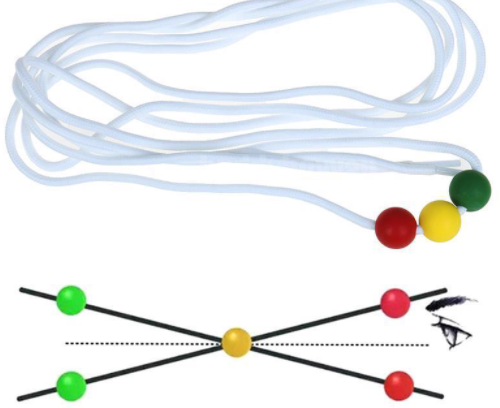The Brock string is a helpful tool when it comes to diagnosing and treating a variety of vision problems.
A Brock string is used by some optometrists to help diagnose and treat some visual skills issues.
The Brock string is a white string around 10 to 15 feet long that contains several colored beads along the length of the string.
The Brock string exercise is commonly used in vision therapy for vergence problems, such as convergence insufficiency, amblyopia (lazy eye) and strabismus (eye turn), to improve double vision, blurred vision, headaches, visual discomfort, dizziness and imbalance.
How is the Brock string used in vision therapy?
The Brock string exercise is primarily used to improve convergence and suppression.
Convergence occurs when both eyes are focused on the same object or image at the same time. Convergence insufficiency makes it difficult to maintain focus on a near object or image and can lead to double vision and eye strain.
Suppression occurs when the brain decides to ignore the visual signals coming from one eye in order to avoid double vision. This can lead to a permanent lazy eye or strabismus, if not treated early on.
The goal of the Brock string exercise is to improve binocular vision, eye teaming and eye coordination, at all distances.
Contact an eye doctor near you to learn more about vision therapy.
SEE RELATED: Do All Optometrists Provide Vision Therapy?
How to perform a Brock string exercise?
- Hold the Brock string with two hands, one at the beginning and the other at the end of the Brock string.
- Hold the one hand up to your nose and stretch the Brock string out by holding the other hand away from you.
- Look at the bead closest to you, it should appear singular, with two shorter strings leading up to it, and two longer strings leading away from it. The two strings should form an “X” as they enter and exit the bead. If this bead appears to be double, you may have a convergence problem. If that is the case, move the nearest bead farther away until it appears as a single bead. As the task grows easier, gradually move this bead closer and closer until it is one inch away from the bridge of your nose.
- Switch your focus from one bead to the next while maintaining awareness that the center of the X has now shifted and there are still two white strings.
- All beads other than the one at the center of the X should appear doubled.
- Repeat this exercise as per your doctor’s instructions, varying the placements of the fixation beads.
As you practice, try to be aware of other objects around you and in your peripheral vision.
Contact an eye doctor near you to learn more about vision therapy.
LEARN MORE: Guide to Vision Therapy
While the Brock string has numerous applications, it is not a do-it-yourself exercise; you will obtain the best results under the supervision of a vision therapy optometrist.


